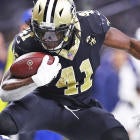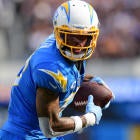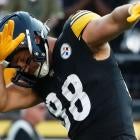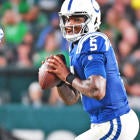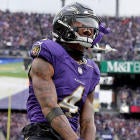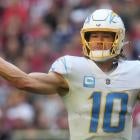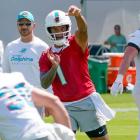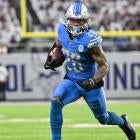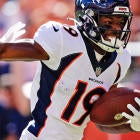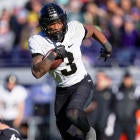With the 2019 regular season in the books, I'll be going division by division to share my initial offseason takeaways from each team.
This is mostly postseason note-taking as I emphasize what stands out most from the Stealing Signals column in 2019. We have an entire offseason of coaching and personnel changes plus additional research to break down what our 2020 Fantasy expectations will be, but I intend to refer back to these pieces as a barometer of sorts.
Atlanta Falcons
Snap Notes: Austin Hooper and Calvin Ridley both missed multiple games after Mohamed Sanu's trade, so a crowded passing game in the first half became a thin one in the second half
Key Stat: Team — 684 pass attempts (51 more than any other team); Julio Jones — 1,908 air yards (most in NFL)
The NFC South was full of passing production in 2019, and five wide receivers from this division will be in contention to go in the top-25 picks in 2020. But no team threw more in 2019 than the Falcons, and it wasn't particularly close. Atlanta's 684 pass attempts were 51 clear of division rival Carolina's 633 in second.
There wasn't much running back production all season, although Devonta Freeman's 59 catches did help him finish RB18 in PPR in just 14 games. He hit 20 PPR points just twice, though, and looks like he's clearly lost a step as a runner as he approaches his age-28 season.
Julio Jones wasn't really himself early, as Austin Hooper had a big first half and was for a time the top-scoring tight end in Fantasy. Hooper went down just after Mohamed Sanu's trade, though, and that concentrated targets to Jones and Calvin Ridley. Eventually, Ridley also went down, and Jones finished the season with an absurd target share and monster games in Weeks 15 and 16. He was second in the NFL in targets and first in air yards en route to his sixth straight top eight PPR finish at the wide receiver position.
Calvin Ridley's season was cut short, so the step forward he took in 2019 might go a bit under the radar in 2020 drafts when compared to the multitude of other young receivers who posted strong 2019 seasons. Ridley's two seasons look very similar, except he only played 13 games in 2020. Mostly shaking off concerns about touchdown regression and a potential target ceiling, he went from 92-64-821-10 in 2018 to 93-63-866-7 in 2019, and his targets were much more stable and production much stronger in the six games he played after Sanu was gone. Ridley is a good bet for 120-plus targets in 2020 with solid efficiency, and the fifth-round price tag he cost in our first two mocks of 2020 is great value.
Hooper was great before his injury, averaging over six catches per game and scoring six times in nine contests. He failed to find the end zone after coming back, but closed the season with back-to-back seven-catch games, and still finished TE6 in PPR despite missing three games. He belongs in the top 10 tight ends for 2020, but is a free agent and there's some uncertainty if he'll be back with Atlanta.
Signal: Austin Hooper — most receiving numbers have steadily improved each season of career
Noise: Calvin Ridley — final 2019 line looks eerily similar to 2018 rookie season, except he missed three games and his production took off after Sanu was traded (he took a clear step forward); Team — overall passing volume
Carolina Panthers
Snap Notes: Highly concentrated; D.J. Moore — played just six snaps in Week 16, missed Week 17; Christian McCaffrey — 100% in six games (rest of league's running backs combined — three games)
Key Stat: Christian McCaffrey — three-year average of 126 targets, 101 receptions, trending up
There's not much that can be said about what Christian McCaffrey did in 2020 except he should be the 1.01 in all drafts in all formats next season. I genuinely can't make a case against him. In part because he plays an unparalleled snap share for a running back, he broke the all-time running back receptions record and also led the league in green zone touches with 36. It should come as no surprise, then, that his 148 high-value touches were 43 clear of any other back, and that workload also makes the third 1,000/1,000 season all time and tying for the league lead in touchdowns both seem more sustainable than they frankly should.
The rest of the Panthers' offense was highly concentrated, and D.J. Moore's age-22 season was particularly notable. His 135-87-1175-4 receiving line came in essentially just 14 games, with a backup quarterback and on a team with a running back soaking up a ton of the overall production. He'll be in line for some positive touchdown regression next year, and if (knock on wood) anything should happen to McCaffrey next year, I would expect Moore to become the focal point of the offense and be a top-five wide receiver during that period. His age-adjusted track record through college and into his first two NFL seasons is just that good.
Curtis Samuel had a wildly inefficient year relative to his volume. Per PFF, no player in the NFL ran more routes in 2019, and Samuel's 1,581 air yards were ninth-most in the NFL. But Samuel finished with just 627 receiving yards — he was the only player in the top 15 of total air yards who didn't post a 1,000-yard season, and you have to go all the way down to the 43rd-most air yards in the NFL to find a player who finished with fewer receiving yards (Brandin Cooks, with 583 yards on 990 air yards).
Samuel will be a great bounce-back candidate in 2019, because while camp reports were glowing all offseason, they were mostly about his connection with Cam Newton. Newton obviously missed the majority of the season, and that connection was not there with Kyle Allen. Player Profiler graded Samuel as having the 105th catchable target rate out of 107 qualifying wide receivers. Apart from the lack of downfield production, Samuel did add 130 rushing yards and a score on the ground, and scored seven total touchdowns for the second straight season. It's not hard to see a strong Fantasy line with reasonable deep ball efficiency.
Greg Olsen had his moments, and Ian Thomas was solid when Olsen missed time. We'll have to see if Olsen is back in 2020, and what we can learn about new coach Matt Rhule's system, but this doesn't project to be an offense with a lot of available tight end opportunity.
Signal: Christian McCaffrey — arguably a perfect Fantasy workload that backs up his production; D.J. Moore — big step forward in Year 2, consistently earned heavy volume
Noise: Curtis Samuel — 627 receiving yards on 1,581 air yards (only player in the top 15 of total air yards to not post a 1,000-yard season, and he wasn't even close)
New Orleans Saints
Snap Notes: Alvin Kamara — 75%+ in seven games (had never previously hit that rate except during Mark Ingram's 2018 suspension)
Key Stat: Alvin Kamara — six touchdowns on 232 touches, 2.4% (previous 31 career games — 31 touchdowns on 476 touches, 6.5%)
In the same vein as McCaffrey, there's both not much to say and everything to say about Michael Thomas. His 85% catch rate in 2018 was the highest ever for any wide receiver with at least 100 targets by nearly eight percentage points and then he backed that up in 2019 with an 80.5% that is still easily the second-highest mark all time. Oh, and he kept his efficiency that high while adding 38 targets to his 2018 total, leading the league at 185 targets by 28 over Julio Jones. When you're that consistently efficient at that type of volume, you can set an all-time receptions record like Thomas did in 2019.
Those receptions are huge in PPR, and in that format Thomas is a top-three player for me. I initially had him above Saquon Barkley at No. 2 overall, but Barkley's late-season surge pushed him ahead of Thomas in my early ranks. Nothing about Thomas' line looks like it should be repeatable, but then it didn't look that way after 2018 and he wound up with an even better season.
Thomas averaged over 110 yards even when Drew Brees missed five games, and he was consistently great week in and week out even as Alvin Kamara was banged up and there was precious little production from the other receiving options. Defenses knew he was the go-to guy and he still racked up numbers, and some of that may be due to his low aDOT and the nature of his receptions, but that doesn't matter much for Fantasy. Even if he loses some targets or some efficiency or some element of his production, the floor here is exceptionally high, especially in PPR. He feels like a near lock for 120 catches for the third straight season.
Of course, we don't know if Brees will be back. And a five-game sample of very good production without Brees doesn't mean Thomas — and the offense as a whole — wouldn't lose a pretty big step if Brees chooses to retire. They would.
Right now, that makes it very hard to like any of the other receiving options. Jared Cook came on strong late, but it was mostly setting a career high in touchdowns with nine and a career high in yards per target at 10.8. He caught just 43 balls on the season, turns 33 in April and his snaps dipped late in the year, so he's only a later-round option for me, and only if Brees is back.
Ted Ginn and Tre'Quan Smith both underwhelmed, and it will be interesting to see if the Saints add to the position in the offseason. They famously brought in Antonio Brown for a workout just before the playoffs, so it wouldn't be particularly surprising if they do upgrade at the position. Smith was an underrated prospect with a strong collegiate track record, but his production has lagged at the NFL level. There's still hope there, but only if he's not blocked by an acquisition.
And of course there's Kamara, who suffered a high ankle sprain and lost some explosiveness as a result. Still, Kamara caught 81 passes for the third straight season, and his value should remain as an elite or near-elite PPR back. I'm fading the lost explosiveness in the passing game and especially fading the six total touchdowns after he scored 31 times in his first 31 career games.
Kamara averaged the second-most high-value touches per game of any running back behind only McCaffrey, and he and Latavius Murray each totaled 14 green zone rushes for the season, while Kamara added five receptions in the green zone and Murray had no catches there. Both backs scored six touchdowns, and 12 combined was far fewer than the 23 and 25 Kamara and Mark Ingram combined for in 2017 and 2018. Especially if Brees is back, I expect the overall running back touchdowns to rise in 2020.
Murray was a suitable No. 2 all year and stepped up big as the lead back when Kamara missed time. But the split did favor Kamara more than it did when Ingram was in town. Kamara played 75% or more of the snaps seven times (including the playoff game), a rate he had only previously hit four times in his career — the four games early in 2018 when Ingram was suspended. Murray should remain a high-upside handcuff with some standalone touchdown potential heading into 2020, assuming no major roster moves.
Signal: Michael Thomas — massive PPR floor with volume and efficiency
Noise: Alvin Kamara/Latavius Murray — 12 combined touchdowns (Kamara/Ingram — 23 and 25 in 2017 and 2018); Jared Cook — very high per-target and per-catch yardage and touchdown efficiency
Tampa Bay Buccaneers
Snap Notes: Ronald Jones — 36% average, 55% weekly high (Week 9); Dare Ogunbowale — 31% average as passing downs back
Key Stat: Jameis Winston — 408.6 air yards per game (most in NFL)
If you read Stealing Signals, you know Ronald Jones' usage in 2019 was frustrating, especially for a truther like me. Jones' touches were sporadic, but at the end of the year his 4.2 yards per carry on 172 carries dwarfed Peyton Barber's 3.1 on 154. How those two backs only had 18 carries separating them when one was able to post solid efficiency behind the 23rd-best run-blocking line per Football-Outsiders' Adjusted Line Yards is beyond me. One of the sillier elements of Jones' usage was his converting six of 10 green zone carries for scores — all from 4 yards out or further — and having to watch Barber eat up goal-line work. Jones also showed off his explosiveness in the passing game, where his 7.7 yards per target were well above league average.
Jones will be a tough player to value in 2020, because it will be hard to trust Bruce Arians. From a longer perspective, though, he looks like a good Dynasty buy as a player who was frustrating for the second straight year for Fantasy purposes and yet what he put on the field should have pretty clearly rehabilitated the bust concerns after his rookie year. Still just 22 until August, there is still room for Jones to become a Fantasy force at some point down the line — a possibility his per-touch efficiency in 2019 speaks well toward — and his Dynasty value likely doesn't match that upside.
Another reason Jones will be hard to value in 2020 is the Bucs are clearly a vertical passing team first. Jameis Winston led the NFL in air yards, and Mike Evans was the main downfield threat until Breshad Perriman took that crown late in the year. Evans had such a dominant lead in total air yards that despite playing just 18 snaps in Week 14 and then missing the final three games of the year, he still finished second in the league in that stat. Perriman then led the league over the final three weeks with Evans out.
There are few receivers with such secure volume, and it's a big reason Evans has started his career with six straight 1,000-yard seasons, even amid annual hand-wringing over his relative inefficiency and inconsistency. The big discussion this offseason will be whether to take Evans or teammate Chris Godwin first, but both should go off the board in the top-10 receivers.
Godwin's breakout year was exactly as advertised — he was the most heavily-targeted slot man in the Larry Fitzgerald role of Arians' system. Godwin's 10.8 aDOT was far lower than Evans' 15.3 mark, but because of that his catch rate was substantially higher and he racked up 19 more receptions than his teammate at similar target numbers. I really like Godwin and believe in his breakout, but as of now I'll still trust Evans' longer track record and downfield volume a bit more in 2020 drafts. Godwin's 11.0 yards per target will be particularly difficult to back up at his low aDOT, but it's not a reason to fade the emerging star.
O.J. Howard was perhaps the biggest bust at the tight end position in 2019, and it's somewhat shocking the targets never materialized. It was clear he was in Arians' dog house — after a solid game against Arizona in Week 10, an early drop that resulted in an interception got him in benched in Week 11 as Cameron Brate went on to catch 10 passes on a season-high snap share.
I still have some faith in Howard. His efficiency dipped, but at 8.7 yards per target he was still on the upper side of things for a tight end. And after two straight seasons over 11 in that stat (2017 and 2018) he currently sits as the most efficient tight end in terms of yards per target since targets were first tracked in 1992 (minimum of 100 targets). That sounds ridiculous, but it's true, and if you want to look at other hyper-efficient young tight ends, we can note his YPT is higher than Mark Andrews or George Kittle.
The issue is targets, and it may remain an issue. But if he can fit in (or be traded?) and see a solid number of looks in 2020 — and if he can score a bit more than the one touchdown he posted in 2019 after 11 across 2017 and 2018 — it's hard not to see him putting up the yardage to be Fantasy-relevant.
Lastly, due to the offense, Perriman will be worth a 2020 flyer — especially in best ball — if it appears he'll be back in his deep threat role.
Signal: Mike Evans/Chris Godwin — dual No. 1s with complementary roles, both top 10 wide receivers for 2020; Ronald Jones — should have clearly rehabilitated the perception after his rookie year that he wasn't very good
Noise: Ronald Jones — no idea what his role in 2020 might be; O.J. Howard — it was a lost season, but his career-to-date numbers are still very strong


















